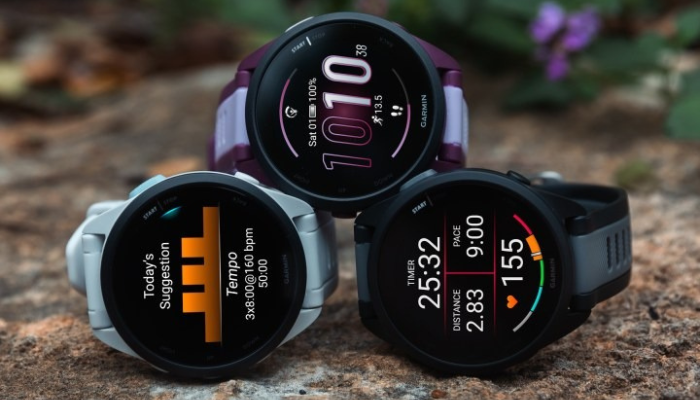Combining premium features in an affordable design creates a top-notch mid-range smart sports tracker
Garmin’s latest smart sports watch condenses all the excellent features found in its higher-end Forerunner models into a more affordable, simpler running tracker. It boasts a bright OLED screen and long battery life.
The Forerunner 165 serves as the new base model in Garmin’s lineup, priced from £250 (€280/$250/A$429), in contrast to the £430 Forerunner 265.
Available in a variety of colors but only one size, the watch features a 1.2-inch screen and 43mm case, positioned between the small and large sizes of the pricier 265.
It’s a comfortable size, featuring a sharp OLED display that’s sufficiently large for easy readability at a glance, while maintaining a slim, lightweight, and compact design on the wrist.
Similar to recent Garmin watches, it offers a great combination of touchscreen and five buttons. Data syncs to an Android or iPhone via the Connect app, connects to your computer via USB cable, or directly to the internet through wifi if you opt for the more expensive version with offline music playback.
The battery typically lasts around five days with continuous screen use, tracking sleep overnight and a single 40-minute run. While this falls a few days short of the 265, it exceeds the battery life of mainstream smartwatch competitors. By setting the screen to activate only when you rotate your wrist, the battery life extends to over 11 days. Each hour of running consumes about 6% of the battery, or 14% with offline music from Spotify, which is ample for most users. A full charge via the USB-C cable takes approximately an hour.
Specifications
Screen: 1.2-inch AMOLED
Case size: 43mm
Case thickness: 11.6mm
Band size: standard 20mm
Weight: 39g
Storage: 4GB
Water resistance: 50 meters (5ATM)
Sensors: GNSS (GPS, Glonass, Galileo), compass, thermometer, heart rate, pulse oximeter
Connectivity: Bluetooth, ANT+ (wifi with music)
Athletic tracking capabilities
The main distinction between the Forerunner 165 and Garmin’s more premium models is the absence of multisport tracking, which includes automated transitions between running, cycling, and swimming for triathlons. However, it does track a total of 24 individual sports, encompassing various types of cycling, running, swimming, walking, hiking, gym activities, and racket sports. Notably, skiing and snowboarding are not included.
For running, the Forerunner 165 monitors standard metrics like time, distance, pace, cadence, and laps. Additionally, it offers running dynamics and power tracking, which are less common but appreciated features for avid runners. During a workout, you can display up to four metrics on the screen simultaneously, with a clear and easily readable interface. In most aspects, the 165 performs almost identically to the 265 or the top-tier Forerunner 965, which is highly commendable.
It does not have dual-band or “multiband” GPS, potentially affecting its location accuracy on paper, especially in challenging environments such as densely built cities or forests. However, in a direct comparison test with a 965 equipped with this feature, both watches quickly acquired a GPS lock and maintained an accurate track and pace, which was quite impressive.
The watch can notify you if you deviate from a planned route but does not offer complete offline maps to show your exact location, a feature currently exclusive to Garmin’s premium watches.
One key absence from the Forerunner 165’s comprehensive sport tracking capabilities is the lack of training readiness, status, and load features found on Garmin’s high-end watches. These measures are valuable for assessing the effectiveness of training towards specific goals, such as improving fitness or preparing for a marathon.
However, the Forerunner 165 does include Garmin’s complete range of general health tracking features. These include sleep and nap detection, daily calorie tracking, step counting, stress monitoring, and other standard smartwatch functions like phone notifications and contactless payments. The only missing feature is the ability to perform an ECG heart scan, which is typically not essential for a sports watch.
Sustainability
The Forerunner 165 is designed to be easily repairable, and options for out-of-warranty exchanges and refurbishment are available. The battery is expected to last for several years of regular charging cycles, maintaining at least 80% capacity. The watch does not incorporate any recycled materials. Garmin commits to providing security updates for at least two years from the release date but often supports its devices for much longer. It also offers trade-in programs for certain product lines and adheres to WEEE and other local electronics recycling regulations.
Price
The Garmin Forerunner 165 is available for £249.99 (€279.99/$249.99/A$429) or £289.99 (€329.99/$299.99/A$499) with offline music support.
For reference, the Forerunner 265 is priced at £429.99, the Apple Watch Series 9 at £399, the Google Pixel Watch 2 at £349, the Coros Pace 3 at £219, and the Polar Pacer Pro at £289.
Verdict
The Forerunner 165 stands out as a remarkable running watch, incorporating the finest elements from its high-end counterparts into a more accessible, cost-effective model.
Featuring a brilliant OLED screen that is easy to read while running, it offers all the essential metrics for monitoring pace and performance. Its extended battery life is sufficient for most users, and its lightweight, compact design ensures comfort even during lengthy training sessions. The combination of touchscreen and buttons sets a new standard in usability.
The primary omissions are offline maps and advanced training metrics. However, the absence of more advanced, multiband GPS tracking does not appear to significantly impact tracking accuracy, an area where Garmin continues to lead.
The main drawback is the price. Priced at £250 or £290 with offline music, it is more expensive than most entry-level running watches. Nevertheless, it aligns with OLED-equipped smartwatches from competitors and offers a £180 saving over the Forerunner 265. Unless you require features specific to triathlon tracking or offline maps, the Forerunner 165 is the ideal Garmin running watch to consider.
